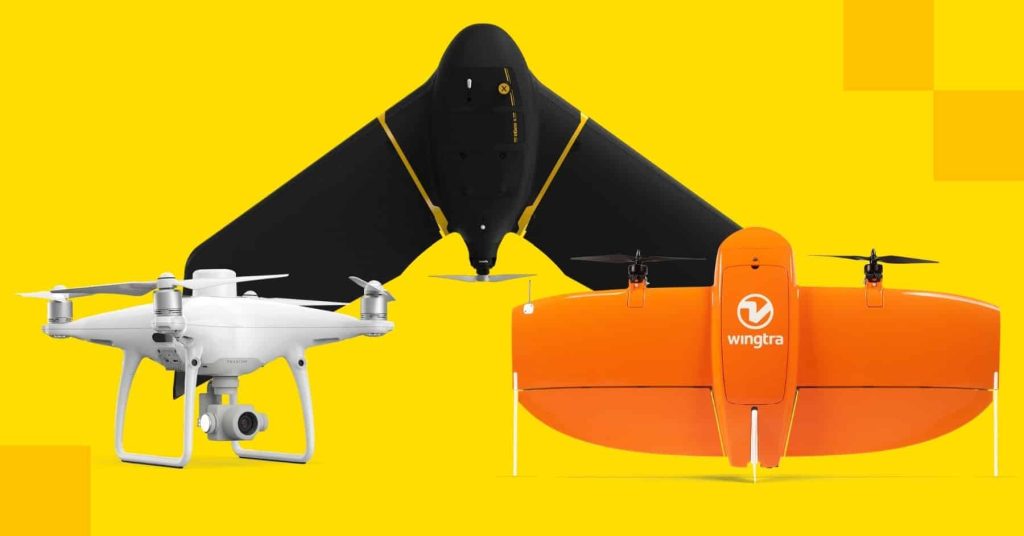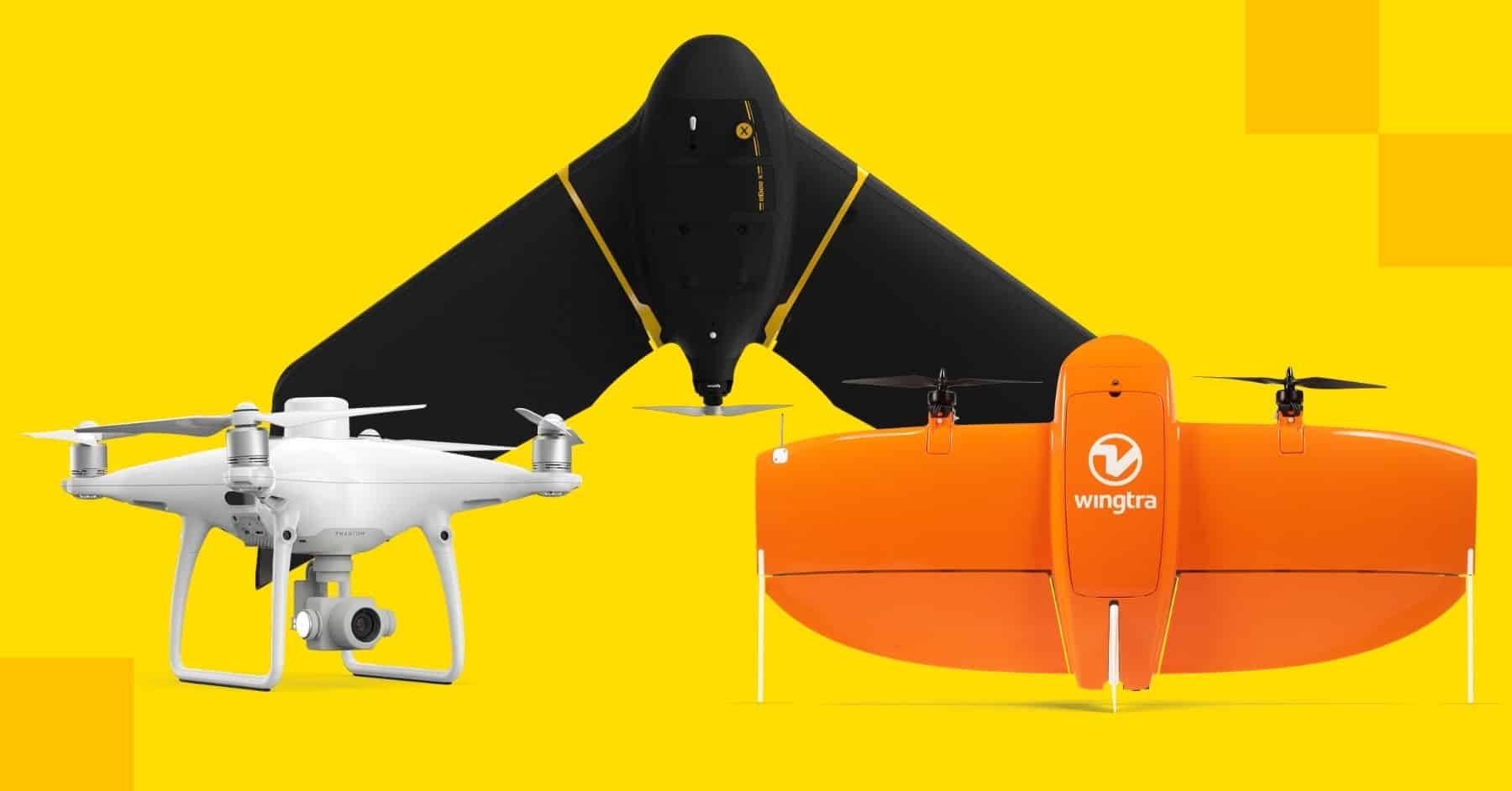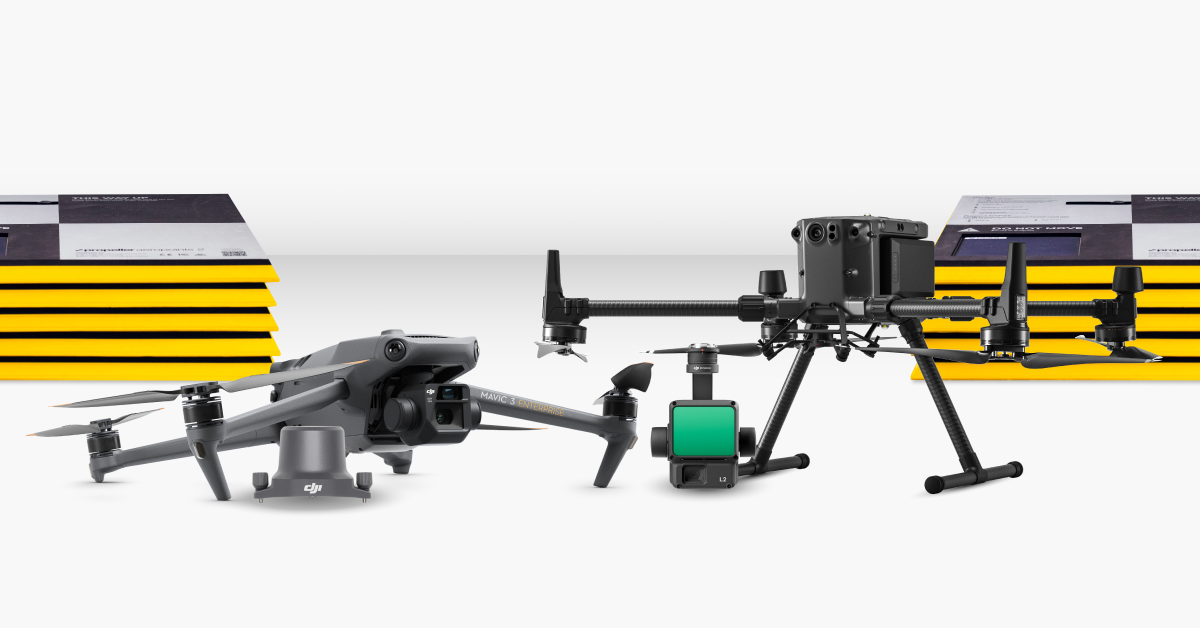Advances in technology have made the drone an affordable tool for worksites. They can have the centimeter-level accuracy of a GPS rover—but unlike traditional surveying equipment, you don’t need special training and a degree to use them.
In short, drones are changing the game for earthworks companies. If you don’t have a drone surveying program yet, now is the time to start!
Whether you’re starting up a program on your worksites for the first time, or scaling the program you already have, you’ll need three major components: the right licenses, the right software, and the right hardware.
Today, let’s talk hardware—drones, to be precise.

Lots of companies over-complicate the process of choosing the right drone for them, which can result in a custom setup that’s both expensive and difficult to scale.
But it doesn’t have to be a tough call. Choosing the right drone for you boils down to three key factors:
- The size of your survey area
- The best camera for your purposes
- Your budget
We’ll talk about the pros and cons of fixed-wing vs multirotor drones in each category so you can decide which drone makes sense for your worksites.
Fixed-wing vs VTOL vs multirotor drones
Let’s start by defining exactly what each type of drone is.
Multirotor drones, like the DJI Phantom 4 RTK, have a central body and multiple rotors (hence the name) that power propellers, enabling flight and maneuverability. Think of a helicopter, but with four rotors on a quadcopter like the Phantom 4 RTK.
VTOL (Vertical Takeoff and Landing) drones, such as the WingtraOne, represent a blended approach, combining elements from both quadcopter and fixed-wing designs. They take off and land vertically like a quadcopter, but act like a fixed-wing drone in flight to facilitate high-efficiency, large-scale mapping.
Fixed-wing drones, for example, SenseFly’s eBee X, look like an airplane, with a central body, two wings, and one or two propellers. They’re becoming more and more popular as drone surveying tools, for reasons we’ll explore below.
Consideration #1: survey area size
Fixed-wing drones fly much faster than multicopters, so they work great for large worksites. For certain jobs, flying just one fixed-wing drone over a site is far more efficient than flying multiple quadcopters, and they can stay in the air much longer on a single battery charge.
After all, you wouldn’t fly a helicopter from LA to New York. The same principle applies to fixed-wing drones and quadcopters.
However, fixed-wing drones typically can’t hover, so they require more space for long, sweeping turns and a runway for takeoff and landing. If you’re working on smaller sites or in urban environments, fixed-wing UAVs might be a bit too fast and require too much space.
VTOL fixed-wing drones like the WingtraOne are an exception, since they have additional propellers that allow them to hover and take off and land vertically like a helicopter.
In many ways they combine the advantages of quadcopters and fixed-wing drones.
Multirotor drones have an advantage in this area, since they don’t need a runway to take off or land. And once in the air, it’s easier for a quadcopter to ascend and descend on a vertical plane, which can be useful.
In one test, a VTOL drone covered 14 times more area on a full battery than the quadcopter it was compared to. The battery life and speed of VTOL drones make them ideal for large-scale projects such as highways, industrial complexes, or mines.
As a general rule, if your site is under 200 hectares (or 500 acres), you can survey comfortably with a multicopter. If you have a larger worksite, consider a fixed-wing or a VTOL drone.
Consideration #2: camera selection
A good camera for surveying should have a 20MP (or better) sensor. And, pay attention to the camera specifications that affect ground sample distance (GSD) and resolution. The GSD is the real-world size of an image pixel, setting a physical limit on the accuracy of your aerial survey. So if your GSD is 5 cm, your survey will only be accurate to 5 cm.
Both fixed-wing and multirotor drones offer high-quality cameras capable of achieving results that are accurate within a fraction of an inch.
However, there are some differences.
We’ve been longtime advocates of the Phantom 4 RTK, but it comes with a static camera setup. There’s no native ability to swap it out if you need higher-resolution images.
Several fixed-wing drone manufacturers offer multiple camera options, so you can get exactly the resolution you’re looking for.
Manufacturers of the VTOL WingtraOne drone, publish repeatedly achievable down to 1 cm absolute accuracy with their 42 MP Sony RX1R II sensor.
To dive deeper into an optimal drone camera setup, check out this post.
Consideration #3: budget
The final consideration? Money.
Fixed-wing and VTOL UAVs are typically around 3.5x the cost of a multicopter drone.
Choose your drone with total cost of ownership in mind.
Multirotors tend to offer a shorter lifespan, with more moving parts that are of lower quality than what you’d find on a more expensive fixed-wing drone. Depending on frequency of use, you might end up replacing your quadcopter every couple of years.
Fixed-wing drones are more costly, but their construction and parts mean that they’ll last longer.
Summary
In general, our recommendation for smaller worksites is the quadcopter. You’ll get great image quality and long enough flight times to accommodate your sites. If you are regularly flying large, open worksites, or if speed is a concern, a VTOL UAV is the drone for you.
Quadcopter Pros:
- Easier and less expensive option
- Great control over position and framing
- Perfect for smaller sites or urban areas
- Easy to learn to fly
Quadcopter Cons
- Limited endurance and speed
- More parts that are susceptible to breaking
VTOL Pros
- Automated vertical take off and landing (no belly landings)
- Durable, fiberglass design
- Ideal for fast and efficient large-scale mapping
VTOL Cons
- Higher price tag than quadcopters
- Larger and more difficult to transport than quadcopters
Fixed-wing Pros
- Faster and more efficient, with longer flight times
- Perfect for large, open worksites
Fixed-wing Cons
- Can’t hover in one spot
- Require more space to operate
- More expensive than quadcopters
- More difficult to learn



